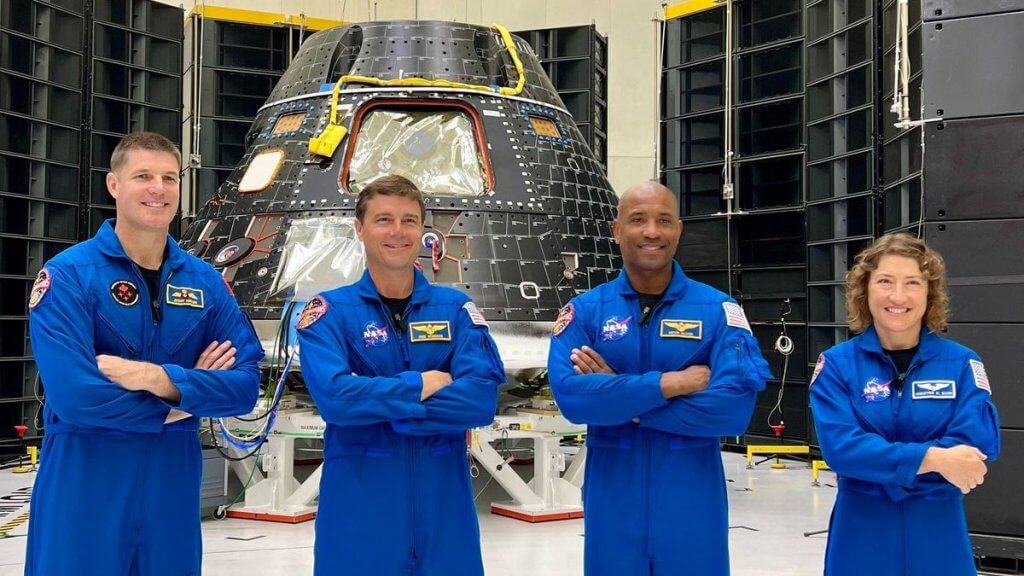CAPE CANAVERAL, FLORIDA — The four astronauts who will launch on a historic moon mission next year just got a good look inside their spacecraft.
The four Artemis 2 astronauts gathered in front of their Orion spacecraft here at NASA’s Kennedy Space Center to talk about the big challenges of getting ready to fly around the moon in November 2024 or so.
The NASA mission will be the first to send astronauts to the moon’s vicinity since Apollo 17 in December 1972. It’s a big challenge, but the Artemis 2 crew says they are ready to meet it — and so are their ground teams.
“This is a developmental mission,” Artemis 2 astronaut Christina Koch said during a gaggle with a small group of reporters in front of Orion on Tuesday (Aug. 8). “We’re going to be training. We’re going to be figuring things out with the team as we go and really embrace the uncertainty.”
Related: How Artemis 2 astronauts are training for their 2024 moon mission
Artemis 2 is the crewed gate-opener of the larger Artemis program, which aims to establish a permanent human presence on and around the moon. It’s the only mission so far with a named crew: NASA’s Koch, Reid Wiseman and Victor Glover, along with the Canadian Space Agency’s Jeremy Hansen.
With the success of the uncrewed Artemis 1 that orbited the moon in late 2022, NASA is already deep in the build of future Orion spacecraft to ferry humans to lunar realms in the coming years.
On display here at the Neil Armstrong Operations and Checkout Building at KSC on Tuesday were three Orion spacecraft, in fact. The trio will carry the crews of Artemis 2 in 2024, Artemis 3 in 2025 or 2026, and Artemis 4 later in the decade, if the first two missions keep to their schedule.
Wiseman, the commander of Artemis 2, emphasized that the crewmembers are using “their own unique backgrounds” to inform the training. (Koch will become the first woman to go around the moon, while Glover will be the first Black astronaut and Hansen the first non-American to do so.)
“You do see it all with a different set of eyes,” Wiseman said of the crew’s individual perspectives, in response to a Space.com question.
And the future is very much in everyone’s minds, he said — not only for training the next crews, but for doing even more difficult missions in the future.
“We are helping influence the design of this,” Wiseman said of Orion, “to help our future astronauts that are going to have much bigger, much more complex missions. So, making this operate as simply as possible for them.”
Related: See Artemis 2 moon astronauts train with US Navy for Orion splashdown (photos, video)
The crew is nearly five months into their training and says the “gelling” happened long before they were assigned to the mission during a star-studded event in April. Hansen and Wiseman were both selected as astronaut candidates for their respective corps in 2009, while Koch and Glover joined NASA in 2013.
Before their selection for Artemis 2, the quartet already knew each other well, they told reporters, and that closeness is apparent. For example, Koch teased Hansen about his height (6 foot 2 inches), which is unusually tall for an astronaut.
Glover joked that he found a solution to crew disputes when he looked inside the open Orion spacecraft on Monday (Aug. 7): “We were able to identify a timeout (area) just in case we need it,” he said, drawing laughter from reporters.
But being with Orion, which will be their home for 10 days on Artemis 2, brought a new perspective to the crew as they continue their training. “Seeing the spacecraft together does bond us in a new way,” Koch said. “There are only three other humans that look at this spacecraft the same way as I do. They’re all standing here, and that is something that we didn’t have before yesterday, and it is special.”
Glover added that the bonding goes beyond the crew to the vast ground teams supporting their mission. Many of the trainers on Artemis 2, for example, will be directly responsible for key systems on the spacecraft. And the Artemis 2 crew spent part of their time here in Florida working with the launch teams.
That’s a deliberate choice by NASA. It allows the astronauts and systems teams to get to know each other long before the moon mission begins, “forming relationships from the highest levels of leadership, all the way down to people who are going in schools as well,” Glover said. “We’re really going to lean on those relationships as we take on several big challenges.”
All four Artemis 2 crewmembers said they’re looking forward to seeing Earth from even farther away than the International Space Station, and then seeing the moon up close. Hansen will be the lone spaceflight rookie on the mission; Wiseman said he will be “excited to see Jeremy glued to the window looking back at Earth” in between testing out the Orion spacecraft in high Earth orbit.
As for the moon, Koch said the astronauts are excited not only to see our lunar neighbor up close, but also to explore the geology from orbit informed by professional training. (Both Koch and Hansen will do a geology expedition in Canada in September, for example.)
“I think even more so we’re excited to take pictures of other people,” she added, saying the crew recognizes they are lucky to explore so distant a location together, as the experience of coming close to the moon will likely mark them profoundly. “That’s something I’m really excited about.”

